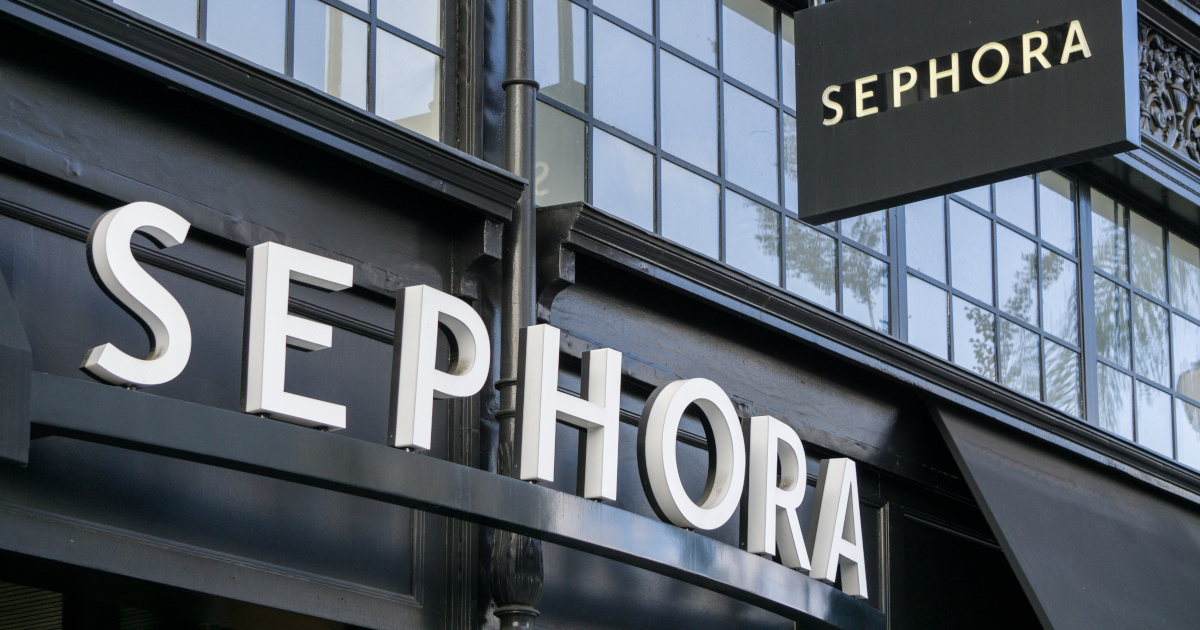Cleaner beauty products are coming to a retailer near you this holiday season.
Mainstream retailers are finally responding to consumer demand for safer beauty products. Retailers like Sephora, Target, and Walmart are increasingly restricting toxic chemicals in beauty and personal care products. This is just in time as states, including Washington, Vermont, and Oregon, will be taking up policies in 2023 to regulate cosmetics as California has done over the past few years.
Since 2019, Sephora has made important progress to reduce toxic chemicals in the beauty and personal care products it sells. Most recently, it reported that it achieved a 39.5% reduction in brand-name products with one or more toxic chemicals between December 2019 and July 2022. And just as important, it invested in tools such as ChemFORWARD and Novi to help suppliers identify and transition to safer alternatives and avoid regrettable substitutes.
This is significant, especially given Sephora’s massive market presence and influence in the beauty sector with its 2,700 stores across 35 countries.
Benchmarking Sephora and other beauty retailers on toxics
We first evaluated Sephora in our 2017 Who’s Minding the Store? Retailer Report Card, which benchmarks leading retailers on toxics, including other beauty retailers such as Ulta Beauty, Sally Beauty, Walmart, and Target. In 2017 Sephora scored a relatively low grade of D. A year and a half after we first evaluated Sephora, the company announced a comprehensive safer chemicals policy and set an ambitious goal to reduce dozens of toxic chemicals in brand-name formulated products by 50% over three years. The list includes nine categories of toxic chemicals, such as phthalates, parabens, and formaldehyde releasers, harmful substances linked to cancer, reproductive harm, or learning and behavior problems.
Four key takeaways on Sephora’s 2022 progress report on reducing toxic chemicals
Last year, we highlighted Sephora’s progress in our 2021 Who’s Minding the Store? Retailer Report Card, naming Sephora the most improved company over time. The company earned an A grade and ranked 4th out of 50 retailers evaluated. And since the 2021 retailer report card was published, Sephora has made even more progress, which it recently disclosed in its latest 2022 progress report.
Here are four key takeaways from the company’s progress report:
- Reducing harmful chemicals: It achieved a 39.5% reduction in products with one or more toxic chemicals between December 2019 and July 2022. While Sephora did not yet achieve its 50% goal, this is good progress. The company also reported that 95.5% of SKUs no longer contain the toxic chemicals it is working to restrict and has created “action plans” for addressing the remaining 4.5% of SKUs they sell that still contain these high-priority chemicals. The company also increased the number of brands recognized in “Clean at Sephora” by 47.7% since 2019, a program that features products free of a longer list of toxic chemicals. It also expanded this list to include six new chemicals or classes including PFAS, octinoxate, nitromusks and polycyclic musks, ethoxylated ingredients, cyclic silicones, and EDTA & derivatives.
- Safer solutions: The company made notable strides in investing in tools and resources like ChemFORWARD and Novi to help suppliers transition to safer alternatives in products and packaging. Sephora funded 26 chemical hazard assessments on the ChemFORWARD platform, which “will be utilized in the Novi Connect tool, making it easier for brands with high-priority chemicals to find fully assessed safer alternatives (ranking a C or better on A-F rating scale).” It also onboarded 121 brands onto the Novi tool, up from 45 in 2021. This is helpful as Novi can help suppliers understand which products contain toxic chemicals and help them identify safer chemicals.
- Beauty products of environmental justice concern: Sephora has also begun to evaluate where it might need to expand its policy to address toxic chemicals in beauty products marketed to people of color, new criteria we added to the retailer report card in 2021. It doubled the number of Black-owned brands it sells, half of which are in its “Clean at Sephora” program. It also educated brands in the Sephora Accelerate program, a brand incubation program focused on founders of color, about harmful chemicals in products and promoted the Novi tool to those brands so they could identify safer alternatives. It is a positive step for the company and much more should be done to address disproportionate exposures to people of color, which our partners at WE ACT for Environmental Justice and other key beauty justice organizations have been leading on for years.
- Metrics matter. Sephora deserves credit for measuring and publicly disclosing numerous metrics on the implementation of its policy, from the percentage of brands and SKUs containing hazardous chemicals, to the percentage of SKUs disclosing ingredients, to the number of chemical hazard assessments it has funded.
And there’s a lot more to digest in the company’s latest progress report.
Sephora’s actions should serve as a model for other retailers in the beauty industry, like Ulta Beauty and Sally Beauty, who are trailing behind in our Report Card.
State regulations increasing
Sephora was also smart to get ahead of regulation in beauty and personal care products, which is increasingly happening at the state level. California leads the states when it comes to requiring disclosure of chemical ingredients, fragrances, and restricting chemicals in cosmetics. Breast Cancer Prevention Partners led efforts to win the “Cosmetic Fragrance And Flavor Ingredient Right to Know Act of 2020,” which requires reporting to the state if the product contains certain fragrance or flavor ingredients appearing on 24 authoritative chemical hazard lists. In 2020-21 laws were adopted in California and Maryland restricting 24 hazardous chemicals used in cosmetics. And in 2022, California and Colorado banned all PFAS in cosmetics. Washington state is also pursuing regulatory action under Safer Products for Washington, restricting all phthalates used as fragrance in cosmetics. And the state legislature will be considering a bill in 2023 restricting all PFAS, phthalates, and formaldehyde and releasers in cosmetics. Oregon, Vermont, and other states will also be taking up measures. This state regulation will only continue to grow.
Recommendations for Sephora to set the pace for the industry
Now that three years have passed since Sephora first announced its goals, this is the time for Sephora to build on its successes and expand its policy even further to reduce and eliminate harmful chemicals in its products and packaging, and ensure substitutes are verifiably safer.
To its credit, the company has already begun to think about how it will do this. Sephora shared that in the year ahead, it will “continue to reduce the high-priority chemicals in our assortment, increase transparency of all products we sell, and expand our brand resources on safer alternatives to avoid regrettable substitution. We will utilize the analysis from this year’s progress report to further expand our policy.” It also announced that it has begun to analyze the presence of additional chemicals of concern in Sephora’s assortment for possible inclusion in future iterations of its Chemicals Policy.
In the year ahead, we recommend Sephora expand its policy in the following key ways:
- Expand the list of priority chemicals and restrict chemical classes of high concern: Sephora should further update its list of priority chemicals, first by evaluating whether other chemicals are missing in the nine chemical classes/categories that it has already restricted (e.g., phthalates, formaldehyde releasers, etc.). The company should take a class-based approach to ensure other hazardous chemicals in these same classes are not present in suppliers’ products. Next, it should expand to include other chemical classes of high concern, especially perfluoroalkyl or polyfluoroalkyl substances (PFAS). Finally, Sephora should identify whether other harmful chemicals are hiding in products it sells by comparing its product assortment with chemicals identified by various authoritative government agencies. We recommend screening against the authoritative hazard lists identified by the Chemical Footprint Project. The company should then inventory the number and pounds of these chemicals in its assortment so it can set a new baseline.
- Set a new time-bound commitment to further reduce its chemical footprint by 50% after setting this baseline. Building on the groundwork it has laid, the company should especially prioritize harmful chemicals in beauty products of environmental justice concern.
- Require full ingredient disclosure for fragrance ingredients. Sephora should require all brands to list ingredients online and on-pack for fragrance ingredients. Right now Sephora’s transparency requirements exempt fragrance ingredients. Sephora customers have a right to know whether chemicals of high concern may be hiding in fragrance.
- Aggressively invest in filling data gaps on the hazards of chemical ingredients. The company should expand its investments in tools like ChemFORWARD, GreenScreen, and Novi to commission chemical hazard assessments to help fill data gaps that allow suppliers to readily identify safer alternatives. This information should also be made publicly available so that all companies can have access to safer ingredient information.
- Require suppliers to ensure substitutes are safe: We urge Sephora to ensure substitutes are verifiably safer. Without assessments of all chemical ingredients, Sephora won’t know whether equally bad or worse substitutes are being used by suppliers. When substituting priority chemicals, Sephora should require suppliers to conduct chemical hazard assessments of alternatives using a tool such as GreenScreen or ChemFORWARD to ensure alternatives are verifiably safer, meeting criteria for GreenScreen Benchmark 2 or higher or ChemFORWARD C or higher. Further, while the evaluation of CAS# or INCI-level data is an essential starting point, moving to the evaluation of trade name ingredients (which are often mixtures of chemicals) is the next step in avoiding regrettable substitution and accelerating the supply chain adoption of safer alternatives.
- Reduce and eliminate toxic plastics. As part of efforts to reduce toxic chemicals and address climate impacts, Sephora should also set goals to reduce and eliminate plastics of environmental health concern (PEHC) in both private-label and brand-name packaging. Plastics are full of harmful ingredients that make its pollution more problematic. And because most are made from fossil fuels, it contributes to climate pollution.
- Support policies in states to eliminate harmful chemicals, fill data gaps, and assess safer alternatives. Government investments and regulation of the most hazardous chemicals help to clean up the supply chain and make it more transparent for companies. Sephora should be supporting policies like those in Washington, Oregon, and Vermont as a way to help achieve its goals and to level the playing field for all companies.
- Publicly disclose its restricted substance list for its private-label products. The company has a larger list of chemicals it restricts in its owned brands it has not yet publicly disclosed.
By continuing to tackle toxic chemicals in its supply chain and ensure substitutes are safer, Sephora can keep ahead of increasing regulations and costs as well as meet the rising consumer demand for clean beauty and personal care products. And states can protect the health of their residents, water, and wildlife by preventing hazardous chemicals in cosmetics and personal care products from being applied to our bodies and going down the drain.
We hope Sephora will continue to demonstrate leadership in the year ahead to further mainstream clean beauty. And we urge others like Ulta Beauty and Sally Beauty to catch up in the year ahead, especially as we prepare our 2023 Retailer Report Card and states put in place more regulations to clean up cosmetics.





